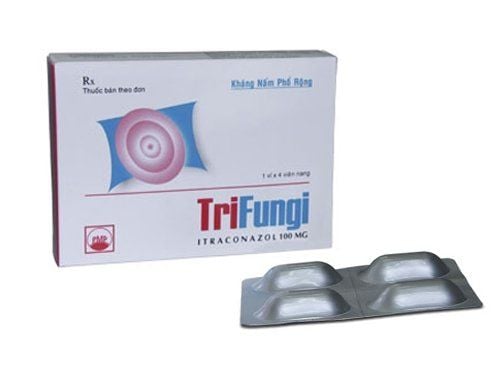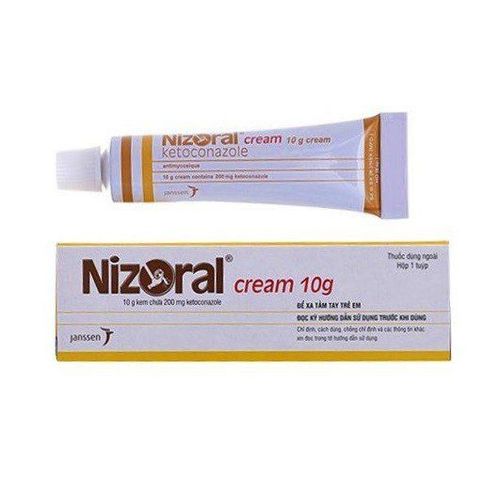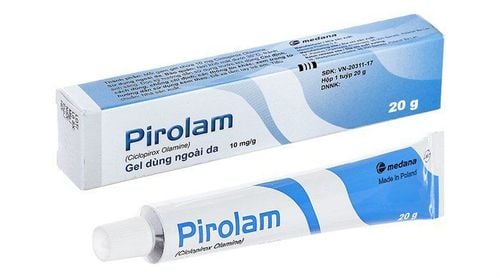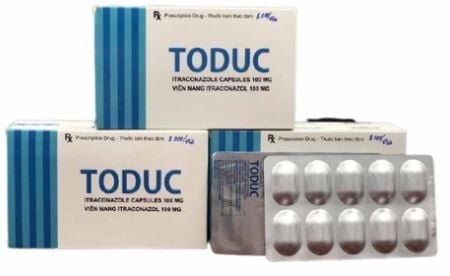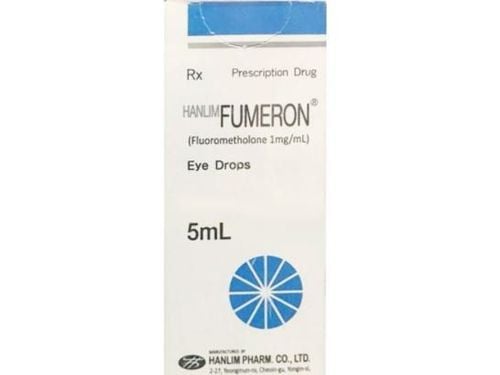This is an automatically translated article.
Drug Tarimagen is often prescribed by doctors to effectively repel vaginal candidiasis, nail fungus, feet or hands,... During the course of treatment with Tarimagen, patients need to adhere to it. Strictly follow all the doctor's instructions to get well soon.
1. What is Tarimagen?
Tarimagen is a prescription medicine used to treat bacterial and parasitic infections, such as candida in the mouth and throat, toenail fungus, ringworm,... Originated from Korea and widely circulated in Vietnam.
Tarimagen is prepared in the form of film-coated tablets and packed in boxes of 10 blisters x 10 tablets. Each Tarimagen tablet contains the following active ingredients:
Main active ingredient: Itraconazole 100mg. Other excipients: Lactose hydrate, Eudragit® E100, gelatinized starch, colloidal silicon dioxide, Lactic acid, hydrated silicon dioxide, Copovidone, Crospovidone, Opadry O4F58644 white, magnesium stearate and carnauba wax.
2. What are the effects of Tarimagen?
2.1. Uses of active ingredient Itraconazole Some in vitro studies have shown that the active ingredient Itraconazole in Tarimagen has an effective inhibitory effect on the growth of pathogenic fungi in humans when at normal concentrations 0.025. - 0.8 mcg/ml. The fungi that Itraconazole can fight against include:
Dermatophytes such as strains of Microsporum spp., Trichophyton spp., or Epidermophyton floccosum. Strains of C. glabrata, C. albicans, C. krusei, Cryptococus neoformans, Pityrosporum spp., Geotrichum spp., Trichosporon spp. Strains Sporothrix schenckii, Fonsecaea spp., Cladosporium spp., Aspergillus spp., Blastomyces dermatitidis, Pseudallescheria boydii, Penicillium marneffei. Tests also show that the active ingredient Itraconazole can disrupt the synthesis of ergosterol of fungal cells. In fact, ergosterol is one of the indispensable components of fungal cell membranes. Thanks to the effect of disrupting the synthesis of this compound, Itraconazole can be an effective antifungal.
2.2. Indications and contraindications to the use of the drug Tarimagen is commonly prescribed by doctors to treat the following fungal or bacterial infections:
Vaginal or vaginal candidiasis. Ringworm or ringworm infection. Candida infection in the mouth or throat. Ocular keratitis caused by a fungal infection. Nail fungus caused by yeast or Dermatophyte. Visceral fungal infections caused by Candida or Aspergillus fungi. Cryptococcus infections, including cryptococcal meningitis. Tarimagen is used in cases of cryptococcal infections in the nervous system or due to immunosuppression when initial therapy is ineffective or inappropriate. Infection with Paracoccidioides, Sporothrix, Histoplasma or Blastomyces. Visceral fungal infection. Fungal infections of the toenails/toenails. Maintenance treatment of patients with AIDs is intended to prevent recurrent latent fungal infections. Prevention of the risk of fungal infection in patients with persistent neutropenia. However, the use of Tarimagen should be avoided in the following cases without a doctor's prescription:
Patients with a history of allergy or hypersensitivity to Itraconazole or any of the excipients of the drug. Relative contraindications to the drug Tarimagen for pregnant women, nursing mothers. The drug should only be used in these subjects when the visceral fungal infection is seriously life-threatening and the benefits of treatment must outweigh the risks of harm. Tarimagen is contraindicated in patients taking other drugs such as Astemizol, Terfenadin, Triazolam, Midazolam and Cisapride.
3. Dosage and instructions for taking Tarimagen
3.1. Dosage of Tarimagen drug as recommended Tarimagen drug is prescribed for use with a doctor's prescription with specific dosages as follows:
Vaginal / vaginal candidiasis: Take 2 tablets x 2 times / day (used for 1 day). ) or 2 tablets/time/day (use within 3 days). Ringworm : Take 2 tablets / time / day and treat within 7 days. Ringworm infections: Take 2 tablets / time / day (use for 7 days) or 1 tablet / time / day (use within 15 days). For highly keratinized areas such as fungal infections of the palms and feet, the patient should take 2 tablets x 2 times/day (used for 7 days) or 1 tablet/time/day (used within 30 days). Candida infections in the mouth/throat: Take 1 capsule/time/day and treat within 15 days. For patients with AIDs, neutropenia or organ transplants, 2 tablets should be taken once a day for 15 days. Treatment of nail fungus: Take 4 tablets / day, equivalent to 2 tablets in the morning and 2 tablets in the afternoon. Take the drug Tarimagen from 2 to 3 times, each session is about 7 days and should be spaced about 3 weeks apart. Or patients can also use Tarimagen for continuous treatment 2 tablets / time / day for 3 months. Treatment of visceral fungal infections: Take 1-2 tablets/time/day. The length of treatment will depend on the specific fungal infection of the patient. 3.2. How to take Tarimagen effectively Tarimagen is formulated as a film-coated tablet, so patients need to take it orally. When taking, you should swallow the tablet whole and avoid chewing or crushing it. In addition, to ensure maximum absorption of Tarimagen, you should take it immediately after a full meal.
Before treatment with Tarimagen, patients should carefully read the instructions for use and follow all recommendations of the doctor. Avoid arbitrarily applying or adjusting the dose of the drug not in accordance with the indications.
4. Side effects when using the drug Tarimagen
During treatment with Tarimagen, patients are at risk of experiencing some of the following side effects:
Common side effects: Headache, dizziness, constipation, nausea, abdominal pain or confusion digestive disorder. Uncommon side effects: Allergic reactions (rash, pruritus, angioedema, urticaria), Stevens-Johnson syndrome, menstrual disorders, hepatitis, reversible elevation of liver enzymes, hepatitis, edema, alopecia, alopecia, hypokalemia or peripheral neuropathy. Rare side effects: Headache, dizziness, diarrhea, severe hepatotoxicity, baldness, photosensitivity, menstrual cycle disturbances. If any of the above mentioned side effects occur after taking Tarimagen, the patient should stop the treatment and promptly notify the doctor so that corrective action can be taken as soon as possible.
5. Notes and cautions when using Tarimagen
The following are some general recommendations for all patients treated with Tarimagen, including:
Itraconazole sensitivity testing should be performed before deciding to use Tarimagen. This is because Candida is resistant to Fluconazole and may not be sensitive to Itraconazole in Candida infections. Although short-term treatment with Tarimagen does not cause liver dysfunction, it should be avoided in patients with a history of liver disease or hepatotoxicity caused by other drug therapy. In cases where treatment for more than 30 days with Tarimagen is required, the patient should periodically monitor liver function. Tarimagen has the risk of causing side effects such as dizziness or headache, affecting the patient's ability to drive machines or vehicles. Therefore, patients who frequently perform these tasks should be treated with caution when treated with Tarimagen. In the event of an overdose of Tarimagen and noticeable symptoms, the patient should be treated immediately for symptoms and possibly gastric lavage if necessary. There is currently no specific antidote for Tarimagen overdose, otherwise Itraconazole cannot be eliminated by hemodialysis (hemodialysis). Avoid co-administration of Tarimagen with drugs metabolised by the cytochrome Pxss 3A enzyme system in order to avoid the risk of interactions that increase plasma concentrations of these drugs and prolong the therapeutic effect as well as external side effects. idea. Check the expiry date and quality of Tarimagen before use. When the medication shows signs of mold, discoloration, or watery discharge, the patient should discard the medicine according to the instructions. Above is all information about Tarimagen drug, patients need to carefully read the instructions for use, consult a doctor / pharmacist before using to ensure safety for health and maximize the effectiveness of the treatment. treat.




